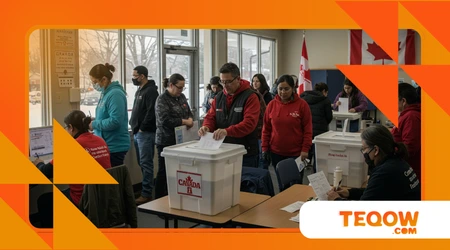Advance Voting Hits Record High, May Signal Increased Election Turnout

Advance voting hits record high in Canada’s 2025 federal election, with an unprecedented 7.3 million ballots cast from April 18 to 21.
This remarkable turnout, reported by Elections Canada, shatters the 2021 record of 5.8 million early votes, hinting at a potentially historic overall voter participation rate for the April 28 election.
Why are Canadians flocking to polls early?
Is this a sign of heightened civic engagement or a strategic shift in voting habits?
This surge reflects a confluence of convenience, political stakes, and a cultural pivot toward proactive participation.
Let’s unpack the dynamics, implications, and what this means for Canada’s democratic landscape.
The 2025 election arrives amid global economic tensions, notably U.S. tariff threats under President Donald Trump, amplifying voter urgency.
Advance polls, open over the Easter long weekend, offered flexibility, drawing diverse demographics, especially younger voters aged 18–40, as noted in social media buzz.
This article explores the catalysts, historical context, and potential outcomes of this early voting wave, weaving in real-time insights and a critical lens on what’s driving Canadians to act.
Why Advance Voting Is Surging
The advance voting hits record high phenomenon stems from practical and psychological triggers. Convenience tops the list: advance polls align with a holiday weekend, freeing schedules.
Elections Canada reported 2 million votes on the first day alone, a 36% jump from 2021’s opening day.
This suggests voters prioritize flexibility, sidestepping election day constraints like work or travel.
Beyond logistics, the election’s stakes are palpable. U.S. tariff threats loom large, with Liberal Leader Mark Carney emphasizing economic stability, while Conservative Pierre Poilievre pushes deregulation and oil expansion.
++: Federal Election Enters Final Week with Carney Leading in the Polls
These contrasting visions galvanize voters, as seen in hour-long lineups in Sudbury and Vancouver. The urgency to shape Canada’s response to global pressures fuels early action.
Social media amplifies this trend. Posts on X highlight young voters dominating polls, rejecting “Boomer” influence.
This generational shift underscores a cultural embrace of early voting as empowerment, not just convenience.
The advance voting hits record high narrative reflects a populace eager to steer the nation’s course.

Historical Context: A Growing Trend
Early voting isn’t new, but its scale in 2025 is unprecedented. In 2019, 4.8 million Canadians voted early; 2021 saw 5.8 million.
The 2025 figure of 7.3 million marks a 25% leap from 2021, per The Globe and Mail. This trajectory suggests a structural shift in voter behavior, favoring advance options.
| Election Year | Advance Votes (Millions) | Total Turnout (%) |
|---|---|---|
| 2019 | 4.8 | 67.0 |
| 2021 | 5.8 | 62.3 |
| 2025 | 7.3 | TBD |
Historically, turnout peaked at 70–80% from the 1950s to 1990s but dipped to 62.3% in 2021, per Reuters.
The advance voting hits record high surge may reverse this decline, signaling robust engagement.
Unlike past elections, where advance voting was a niche choice, it’s now a mainstream strategy.
Consider 2015, when a Liberal wave swept Justin Trudeau to power. Advance polls then showed Conservative strength, but election day flipped results.
Today’s broader early turnout, spanning Liberal and NDP strongholds, suggests a less predictable outcome, complicating party strategies.
Also read: How Provincial Governments Are Addressing Affordable Housing Shortages in 2025 alla romana
Catalysts Behind the Record Turnout
What’s driving this fervor?
Accessibility is key. Advance polls, open 12 hours daily, cater to diverse schedules. In London, Ontario, voters like Eric Gireada, 24, cited convenience, telling CBC, “It’s easier than election day.”
This resonates nationwide, with polling stations like Science North in Sudbury seeing hour-long queues.
Political polarization also plays a role. The advance voting hits record high wave coincides with a tight race.
An Ipsos poll from April 17–19 shows Liberals leading Conservatives by three points, with NDP’s Jagmeet Singh urging voters to “not put all power in one party.”
This competitive landscape spurs action, as voters sense their ballot’s weight.
Cultural shifts further explain the surge. Young voters, inspired by global movements, see voting as activism.
A Reddit user in Etobicoke described “pride” in waiting in line, a sentiment echoing across platforms.
The advance voting hits record high trend is thus both practical and symbolic, reflecting a reinvigorated democratic spirit.
Implications for Election Day
What does this early wave portend? High advance turnout doesn’t guarantee a record overall turnout, but it’s a strong indicator.
Darrell Bricker of Ipsos notes that advance surges often signal higher election day participation, though some voters may simply be shifting habits.
The advance voting hits record high data suggests a potential climb above 2021’s 62.3%.
Parties must adapt. Conservatives historically dominate advance polls, as seen in Pierre Poilievre’s 2021 Carleton riding win.
Yet, 2025’s diverse early voter base spanning urban Liberal and NDP ridings challenges this edge.
Campaigns now focus on mobilizing remaining voters, with Carney rallying in Ottawa and Poilievre in Toronto.
The surge also pressures Elections Canada. Long lines prompted adjustments, like extended poll hours.
A Vaughan incident, where a worker allegedly pushed Conservative votes, underscores scrutiny on process integrity.
The advance voting hits record high phenomenon demands robust systems to sustain trust.
A Deeper Look: Voter Motivations
Digging deeper, voter motivations reveal a tapestry of intent. Economic fears, driven by U.S. tariff talks, resonate widely.
Carney’s platform, emphasizing trade resilience, draws urban voters, while Poilievre’s deregulation pitch sways energy-rich regions.
This divide fuels early voting as a preemptive strike.
Demographic shifts are striking. X posts highlight 18–40-year-olds leading the charge, unlike 2021’s older-skewing advance polls.
Consider Sarah, a 27-year-old Toronto nurse, who voted early to “secure a future against trade wars.” Her story mirrors thousands, blending pragmatism with idealism.
Contrast this with rural voters like John, a 45-year-old Alberta farmer, who voted early to support Poilievre’s oil agenda.
These examples illustrate how advance voting hits record high reflects diverse priorities, unified by a shared sense of urgency. Are Canadians voting to protect or to disrupt?
The answer lies in the ballots.
The Role of Technology and Media
Technology shapes this trend. Elections Canada’s online voter tools, like ID guides and poll locators, streamline participation.
Social media, especially X, amplifies urgency, with posts like @anthonydoes noting “hour-long lines” and youth dominance.
This digital momentum sustains the advance voting hits record high narrative.
Mainstream media reinforces this. CTV’s real-time coverage of lineups in Vancouver and Sudbury creates a feedback loop, encouraging turnout.
However, misinformation like debunked pencil-use claims requires vigilance. Elections Canada’s proactive clarifications maintain trust, ensuring the surge isn’t derailed.
The interplay of tech and media transforms voting into a communal act. When a Reddit user shares, “This was the busiest poll I’ve seen,” it inspires others.
This dynamic, blending information and emotion, underpins the advance voting hits record high phenomenon, making democracy feel immediate and vital.
Looking Ahead: What’s Next?

As advance polls close, attention shifts to April 28. The 7.3 million early votes over 25% of 28 million registered voters set a high bar.
Will election day match this energy? Historical trends suggest yes, but urban-rural divides and weather could sway outcomes.
Parties face a sprint. Poilievre’s Toronto stops and Carney’s Ottawa rallies aim to lock in undecideds. Singh’s metaphor “don’t put all eggs in one basket” resonates with cautious voters.
The advance voting hits record high surge pressures campaigns to innovate, not coast.
Elections Canada’s role grows critical. With 720,654 mail-in ballots already received, per The Globe and Mail, logistics must hold.
The advance voting hits record high milestone is a triumph, but sustaining momentum requires flawless execution. Canada’s democratic pulse is strong will it endure?
An Analogy for Engagement
Picture advance voting as a river swelling before a dam. Each ballot adds to the flow, building pressure that could reshape the landscape on election day.
This surge, like a river, carries diverse currents youth activism, economic fears, and convenience merging into a powerful force.
The advance voting hits record high phenomenon is Canada’s democratic river, ready to carve new paths.
Conclusion: A Democratic Awakening?
The advance voting hits record high milestone in 2025 is more than a statistic; it’s a signal of Canada’s democratic vitality.
With 7.3 million early votes, Canadians are seizing control of their future amid global and domestic stakes.
This surge, driven by convenience, polarization, and youth energy, challenges parties and Elections Canada to match this fervor.
Whether it heralds a record overall turnout remains unseen, but the signs are promising.
This moment invites reflection: what drives you to vote early or wait? The answer shapes not just April 28 but Canada’s trajectory.
As lines form and ballots stack, one truth emerges Canadians are engaged, vocal, and ready to act. Let’s carry this energy forward, ensuring every voice counts in this pivotal election.
Frequently Asked Questions
1. Why did advance voting hit a record high in 2025?
Convenience, high election stakes, and youth engagement drove the 7.3 million early votes, amplified by holiday timing and media buzz.
2. Does high advance voting guarantee high overall turnout?
Not necessarily, but it’s a strong indicator. Past trends show early surges often correlate with higher election day participation.
3. Who can vote in advance polls?
Any registered Canadian voter with valid ID, such as a driver’s license or voter card, can vote at advance polls.
4. How does advance voting affect party strategies?
Parties must adapt to diverse early voter demographics, focusing on mobilizing remaining voters and addressing urban-rural divides.
5. Where can I find more election information?
Visit Elections Canada’s website (elections.ca) for voter guides, poll locations, and real-time updates on the 2025 election.
